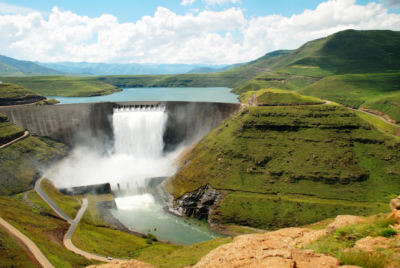More than 2,000 years ago people in Greece were using flowing water to turn the wheels of their mills, grinding wheat into flour. More recently, for the past several decades people have been using flowing water to generate electricity.
Using the Power of Water to Produce Renewable Power
Hydroelectric energy (aka hydroelectric power and hydroelectricity), as described by National Geographic, “is a form of energy that harnesses the power of water in motion—such as water flowing over a waterfall—to generate electricity.”
In the case of hydroelectricity, the waterfalls are dams, massive barriers built across rivers and streams to confine and govern the flow of water for human use, such as irrigating and generating hydroelectricity.
Over the years, technology has advanced significantly and the capabilities of hydroelectric power stations have continued to evolve and improve. Today, hydroelectricity is the most used renewable source of electricity. Roughly 71% of the renewable electricity generated on Earth is from hydropower. The top producers of hydropower around the world include China (as the lead producer), the U.S., Brazil, Canada, India, and Russia.
Meet the Largest Dams
Not all dams are created equal, and some dams are much larger and/or more effective than others when it comes to generating power. Keep reading below to learn about some of the largest dams throughout the globe:
1. The Three Gorges Dam – Hubei, China
In terms of electricity production, the Three Gorges Dam became the largest hydroelectric dam in the world in 2012. This massive facility can generate as much as 22,500 megawatts and can generate 11 times as much power as the Hoover Dam. Thanks to the overwhelming mass of its reservoir, this dam is even capable of slowing the Earth’s rotation.
2. Itaipu Dam – Brazil/Paraguay Border
Prior to the Three Gorges Dam, the Itaipu Dam held its place as the world’s largest dam since it officially opened in 1984. This astounding facility is able to generate 14,000 megawatts of electricity and has achieved multiple world records, including having generated 103,098,366 megawatt-hours in 2016, which remains the current world record.
3. Xiluodu Dam – Jinsha River, Yunnan, China
The Xiluodu Dam is the second-largest hydroelectric facility in China, and worldwide, it’s the third-largest hydroelectric facility in terms of electricity generation. This dam can generate 13,860 megawatts of electricity. The Xiluodu Dam is also the fourth tallest dam in the world, measuring at a height of 937 feet (285.5 meters).
4. Tucuruí Dam – Brazil
Built in 1975, this dam can generate as much as 8,370 megawatts of electricity and has brought power to 13 million people. It is Brazil’s largest hydroelectric plant that’s owned and operated 100% by the country.
5. Grand Coulee Dam – Washington State, United States
The Grand Coulee Dam isn’t just one of North America’s most powerful dams but also one of the seven civil engineering wonders of the U.S. The gigantic structure comprises 12 million cubic yards of concrete. Built in 1942, the dam can generate 6,809 megawatts, which makes it the most powerful dam in all of the United States
Other Benefits of Dams
There’s no doubt that the size of these dams is impressive, but did you know that there are many advantages to both humans and the planet offered by hydroelectric energy? Some of these benefits include:
- Because it’s fueled by water, hydropower is considered a “clean fuel source,” meaning it won’t pollute the air.
- Hydroelectric power is a domestic source of energy, so it allows each state to produce its own energy and eliminates the need to utilize international fuel sources.
- Hydroelectricity is a renewable power source, which makes it a reliable and affordable energy source.
- Hydropower plants can generate power to the grid instantaneously and are therefore able to provide essential back-up power during major electricity outages or disruptions.
- Hydropower efforts produce a number of benefits, such as flood control, irrigation, and water supply.
As you’ve hopefully learned, hydroelectricity is an energy source that can be tapped to create a more sustainable future. Although the ones we’ve talked about are some of the world’s largest dams, there are lots more out there and lots more to come!
If you’re interested in switching your energy supplier, be sure that you check out Kiwi Energy’s innovative electricity and natural gas plans today!


